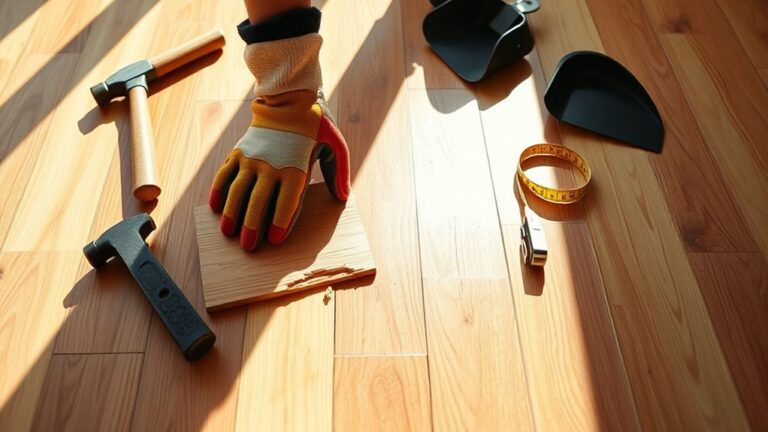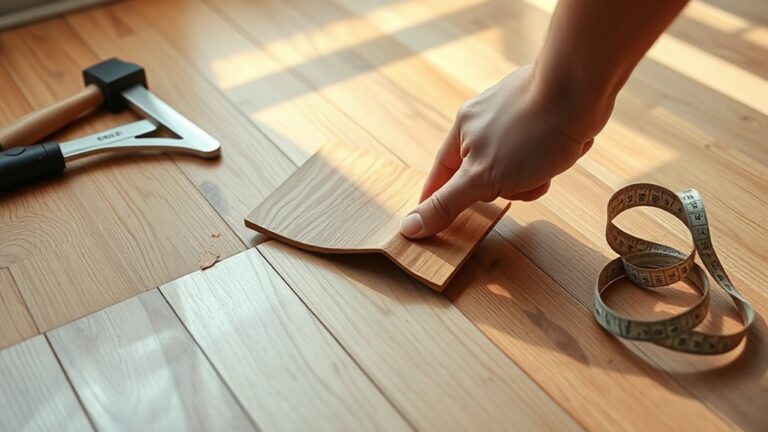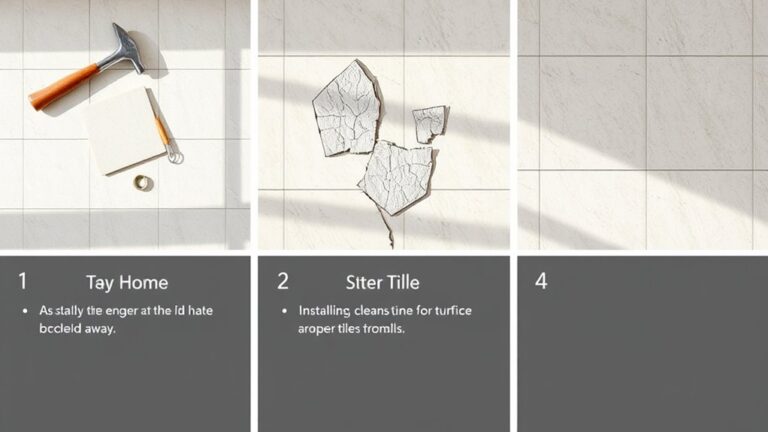Common mistakes in hardwood floor maintenance can lead to severe damage. You might be using excessive water while cleaning, which can cause warping. Harsh cleaners and abrasive tools can strip finishes and create scratches. Ignoring regular maintenance allows dust to accumulate, dulling your floors' shine. Don't forget the importance of humidity; improper levels can lead to cracks and expansion. Furniture pads are also essential to prevent scratches from heavy items. Finally, neglecting pet nails can create unwanted scratches. Each of these errors can be easily avoided, and there's more you can do to protect your hardwood floors effectively.
Excessive Water Usage
When it comes to cleaning hardwood floors, using excessive water can spell trouble for your beautiful surfaces. You might think a soaking wet mop will leave your floors sparkling, but that's far from the truth. Excessive water usage can lead to moisture seeping into the seams of your hardwood, resulting in swelling and warping of the floorboards over time. This isn't just a cosmetic issue; it can compromise the integrity of your floors.
Cleaning with a wet mop might give you immediate satisfaction, but it can also create water stains and permanent damage due to the wood's highly absorbent nature. Instead, consider using a slightly damp mop, thoroughly wringing it out before use to minimize moisture exposure. This simple adjustment can make a significant difference in preserving the longevity of your hardwood floors.
If you're looking for the best results, professional cleaning services have advanced techniques for moisture control that can protect your investment. They understand the delicate balance needed to maintain the beauty and durability of hardwood.
To keep your floors looking their best, prioritize preventative measures. Using damp cloths instead of wet mops can help you maintain cleanliness without the risks associated with excessive water usage. By being mindful of the moisture you apply during cleaning, you can guarantee your hardwood floors remain stunning and intact for years to come.
Harsh Cleaning Products
While managing moisture is essential for hardwood floor care, the choice of cleaning products is equally important. You might think that stronger cleaning agents will yield cleaner floors, but using harsh cleaning products like ammonia, bleach, or wax can be detrimental. These substances can strip away the protective finish, leading to discoloration and reduced durability over time.
Moreover, abrasive solutions can create micro-scratches on your hardwood, compromising its aesthetic appeal and making it easier for dirt to accumulate. You want your floors to look their best, and choosing the wrong cleaner can undermine that effort.
Instead, opt for pH-neutral, non-toxic cleaners that effectively remove dirt without damaging the wood or its finish. These gentle yet effective solutions maintain the integrity of your flooring and prolong its lifespan. Specialized cleaning products designed specifically for hardwood maintenance can further enhance your results. They help prevent buildup and keep your floors looking fresh, reducing the need for frequent refinishing or costly replacements.
Ignoring Regular Maintenance
Ignoring regular maintenance can lead to considerable issues for your hardwood floors. Over time, dust and dirt accumulate, causing micro-scratches that dull the finish and diminish the overall aesthetic appeal. Regular maintenance isn't just a chore; it's essential for preserving the beauty and longevity of your floors.
Start with routine sweeping or vacuuming to prevent the buildup of debris. This simple action helps prevent scratches and protects against more severe wear and tear. If you want to guarantee your floors stay in pristine condition, consider professional cleaning services that can reach fine particles regular cleaning might miss. They can provide a deep clean that extends the life of your hardwood.
Also, don't underestimate the importance of addressing spills immediately. Failing to clean up moisture promptly can lead to it seeping into the floorboards, causing swelling and irreversible damage. This is one area where a little vigilance pays off remarkably.
Skipping the Welcome Mat
Often overlooked, the importance of a welcome mat cannot be underestimated when it comes to protecting your hardwood floors. Welcome mats serve as a first line of defense against dirt and grit that can be tracked indoors from shoes. Studies show that up to 80% of dirt and dust in homes originates from shoe traffic, making these mats an essential preventive measure for floor care.
By placing breathable welcome mats at all entry points, you can greatly reduce the amount of moisture and debris that makes its way into your living spaces. This simple action minimizes the risk of scratches and damage to your hardwood floors, ensuring their longevity and beauty. Regular cleaning and maintenance of these mats enhance their effectiveness, preventing dirt accumulation that could otherwise be transferred to your floors.
In addition to welcome mats, consider using area rugs in high-traffic zones. This combination creates an even more robust barrier against wear and tear on your hardwood surfaces. Remember, investing in quality welcome mats and maintaining them is a small yet impactful step toward preserving the elegance of your floors.
Using Abrasive Tools
When it comes to maintaining the beauty of your hardwood floors, using abrasive tools can be one of the most detrimental mistakes you can make. Tools like steel wool and harsh brushes can scratch and dull your floor's finish, leading to irreversible damage. Once those scratches appear, it can be nearly impossible to restore the floor's original luster without professional help.
For effective hardwood flooring maintenance, it's essential to choose the right cleaning tools. Instead of reaching for those abrasive options, consider using a microfiber mop. These mops are designed to capture dirt and dust without scratching the surface, making them an ideal choice for regular cleaning. Not only will they help maintain your floor's appearance, but they'll also prolong its lifespan.
When it comes to stain removal, always opt for specialized cleaning products designed for hardwood care. These products are formulated to clean without the damaging effects of abrasives. Knowledgeable technicians can also provide assistance, utilizing non-abrasive tools and methods to clean and restore your floors safely.
Neglecting Pet Nail Care
One of the most overlooked aspects of hardwood floor maintenance is the care of your pet's nails. Untrimmed nails can create considerable scratches on your hardwood floors, leading to costly repairs and diminished aesthetics. To prevent this damage, it's crucial to establish a regular pet nail care routine, aiming for a trim every 4-6 weeks. This simple practice can greatly extend the life and appearance of your flooring.
In addition to regular trimming, consider using pet nail caps. These soft coverings provide an extra layer of protection against scratches while allowing your furry friends to roam freely. They're an effective way to minimize wear on your hardwood surfaces without restricting your pet's movement.
Another smart strategy is placing area rugs in high-activity zones where your pets frequently play or rest. These rugs can absorb impacts and protect your hardwood floors from scratches and dents caused by sharp nails. By being proactive about your pet's nail care and flooring protection, you can maintain the integrity of your hardwood floors.
Awareness of pet care, including regular grooming, directly impacts the longevity and overall look of your flooring. By taking these steps, you not only safeguard your investment but also create a more harmonious living space for both you and your pets. So, prioritize pet nail care to keep your hardwood floors looking their best for years to come.
Improper Humidity Management
Pet care isn't the only factor that affects your hardwood floors; humidity levels in your home play a vital role in their maintenance. Improper humidity management can lead to serious issues that compromise the integrity of your hardwood flooring. Here are three essential points to keep in mind:
- Optimal Range: Maintaining indoor humidity between 30% to 50% is essential. Deviating from this range can result in wood expansion and contraction, causing warping and cracking.
- Effects of Humidity: High humidity can cause your hardwood floors to swell, while low humidity may lead to shrinking and gapping. Both scenarios can greatly weaken the flooring's structural integrity.
- Proactive Monitoring: Utilize a hygrometer to monitor humidity levels in your home. This allows you to take proactive measures to regulate moisture, whether it's using humidifiers during dry seasons or dehumidifiers in more humid conditions.
Regularly checking and adjusting humidity levels can save you from costly repairs or replacements caused by moisture-related damage. By understanding the importance of proper humidity management, you can preserve the quality and longevity of your hardwood floors. Remember, keeping an eye on moisture isn't just about aesthetics; it's about maintaining the health and integrity of your investment.
Furniture Protection Oversights
When it comes to protecting your hardwood floors, using furniture pads is essential to prevent scratches and dents. You might not realize that these pads wear down over time, so it's important to check and replace them regularly. Additionally, always lift furniture instead of dragging it to avoid causing significant damage to your floor's surface.
Importance of Furniture Pads
Neglecting to use furniture pads under heavy furniture can lead to significant damage to your hardwood floors. Here are three reasons why you shouldn't overlook this vital step:
- Prevention of Scratches: Furniture pads act as protectors, reducing the risk of scratches and dents from heavy items.
- Weight Distribution: The weight of your furniture can compress hardwood surfaces, but pads help distribute that weight evenly, minimizing damage.
- Noise Reduction: Using furniture pads can also lessen the noise when moving furniture, creating a more peaceful living space.
Regularly check and replace worn-out furniture pads, as damaged protectors can expose your floors to costly repairs. Without them, your hardwood floors are more vulnerable to wear and tear from daily activities, potentially leading to premature refinishing or even replacement. Protecting your investment is essential; it's not just about aesthetics but also about maintaining the longevity of your flooring. By using furniture pads, you'll keep your hardwood looking great and extend its lifespan. Take the time to invest in these simple yet effective protectors, and you'll enjoy the beauty of your floors for years to come.
Moving Furniture Safely
Moving furniture can be a challenging task, especially when it comes to protecting your hardwood floors. To move furniture safely, you need to prioritize the protective effectiveness of your chosen methods. Using furniture pads or felt protectors under the legs of your furniture can greatly reduce the risk of scratches and dents. Remember, dragging heavy items across your hardwood can lead to irreversible damage, including deep scratches that mar the surface.
Lifting furniture instead of dragging it is another key practice. This simple action can dramatically minimize scuff marks and preserve the floor's integrity. Furthermore, regularly check and replace worn or damaged furniture pads to maintain their protective effectiveness.
Additionally, consider placing area rugs in high-traffic areas. They not only protect your hardwood from furniture but also offer cushioning against impacts and abrasions. By incorporating these strategies, you can prevent floor damage and keep your hardwood looking pristine for years to come. Moving furniture doesn't have to be an overwhelming experience; with the right precautions, you can guarantee that your floors remain beautiful and intact.
Frequent Cleaning Mistakes
One of the most common hardwood floor maintenance mistakes involves using the wrong cleaning products. If you want your floors to shine without damage, it's vital to choose wisely. Here are three frequent missteps to avoid:
- Harsh Cleaners: Many people reach for ammonia-based solutions, unaware that they strip protective finishes and can lead to discoloration.
- Wax-based Cleaners: These can create a buildup, complicating future refinishing. You'll end up with a dull surface instead of the luster you desire.
- Excessive Moisture: Over-cleaning with too much water can warp your floorboards, leaving you with an uneven surface.
To guarantee effective hardwood floor cleaning, stick with pH-neutral products specifically designed for wood. These cleaners gently remove dirt while preserving the finish. Regular cleaning is essential, but don't forget that spills need prompt attention. Neglecting to clean them right away can allow moisture to seep into the floorboards, leading to swelling and permanent damage.
When mopping, always use a slightly damp mop rather than soaking the floor. This simple adjustment can make a world of difference in maintaining the integrity of your hardwood floors. By avoiding these common cleaning mistakes, you'll keep your floors looking beautiful while extending their lifespan. Remember, the right approach empowers you to enjoy your hardwood floors freely and confidently.
Frequently Asked Questions
What Are the Do's and Don'ts of Cleaning Hardwood Floors?
When cleaning hardwood floors, use damp mopping techniques to minimize moisture exposure. For maintenance frequency, sweep or vacuum regularly to prevent scratches. Stick to product recommendations that avoid harsh chemicals like ammonia, which can damage finishes. Implement protective measures by placing breathable mats at entryways to reduce dirt and moisture. By following these do's and don'ts, you'll guarantee your hardwood stays beautiful and lasts for years without unnecessary wear.
What Not to Do When Refinishing Hardwood Floors?
They say, "an ounce of prevention is worth a pound of cure." When refinishing hardwood floors, avoid common pitfalls. Don't sand too aggressively—sanding mistakes can ruin your floor. Be cautious with finish types; never apply new finish over old without prep. Always respect drying time; rushing can create unsightly bubbles. Finally, steer clear of harsh chemicals—they'll strip your floor's beauty. Stick to proper refinishing techniques, and your floors will thank you!
What Maintenance Do Hardwood Floors Need?
Hardwood floors need consistent care to maintain their beauty and durability. Start with humidity control to prevent warping. Regular inspections help you catch any damage early on. For scratch prevention, use area rugs in high-traffic areas and consider your furniture placement to avoid dents. You'll want to sweep or vacuum frequently and use pH-neutral cleaners. Following these steps guarantees your floors stay stunning and last for many years.
What Is the Best Thing to Use to Clean Hardwood Floors?
You might think any cleaner will do for hardwood floors, but that's a misconception. The best cleaning solutions are pH-neutral and non-toxic, like Bona Hardwood Floor Cleaner. If you prefer natural cleaning alternatives, try a mix of vinegar and water, though sparingly. Clean frequently using common tools like a microfiber mop to avoid dirt buildup. Remember, a slightly damp mop is best to protect your floors from warping. Happy cleaning!




